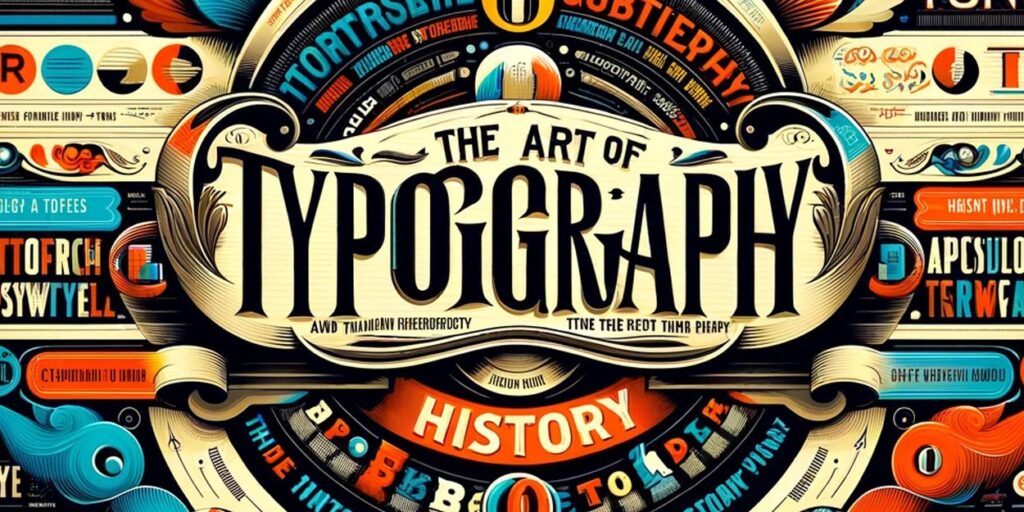The Historical backdrop of Typography: From Gutenberg to Advanced Text styles
Typography, the craftsmanship and strategy of orchestrating type, is a key part of composed correspondence. It has advanced over hundreds of years, forming the manner in which we read and decipher text. From the development of the print machine in the fifteenth hundred years to the computerized text styles of today, typography significantly affects writing, culture, and plan. This article investigates the historical backdrop of typography, featuring key achievements and innovative progressions that have impacted how type is utilized across various media.
The Introduction of Typography: Gutenberg’s Print machine
The historical backdrop of typography started with the development of portable sort by Johannes Gutenberg during the fifteenth 100 years. Before this forward leap, books were carefully transcribed by recorders, making them costly and interesting. Gutenberg’s innovation of the versatile kind press around 1440 reformed the development of books by permitting individual letters to be organized on a print machine and inked to make numerous duplicates. This development radically decreased the expense and time expected to deliver composed material, prompting the spread of information and education across Europe.
Gutenberg’s most well known work, the Gutenberg Book of scriptures (around 1455), is viewed as one of the primary books printed utilizing versatile sort. The typefaces utilized in this early period were vigorously motivated by the written by hand original copies of the time, for example, blackletter (likewise called Gothic sort), which was described by its thick, precise structures. While these typefaces were useful, they were likewise profoundly fancy, mirroring the middle age stylish of the time.
The Ascent of Humanist Typefaces
In the sixteenth 100 years, a change in typographic plan started to arise. As the Renaissance thrived, humanism – a social development that underlined the investigation of old style Greek and Roman texts – impacted numerous areas of workmanship and configuration, including typography. The requirement for a more decipherable and rich typeface prompted the making of humanist typefaces, which were motivated by the letterforms tracked down in traditional compositions.
One of the vital figures in this change was Aldus Manutius, an Italian printer and distributer, who established the Aldine Press in Venice. During the 1490s, he presented the italic typeface, a skewed variety of Roman kind that was intended for quicker composing and printing. This recent fad turned out to be especially well known for its style and comprehensibility, and its presentation denoted a defining moment in the development of typography.
The period additionally saw the advancement of the Roman typeface, which depended on the letterforms of antiquated Roman engravings. This more regularized, less elaborate style diverged from the weighty strokes of blackletter type and turned into a vital quality of Renaissance typography.
The Modern Insurgency and the Introduction of Present day Typography
The Modern Upheaval in the eighteenth and nineteenth hundreds of years achieved critical progressions in printing innovation, which significantly affected typography. The development of the steam-controlled print machine and the ascent of large scale manufacturing made printed materials more open to the overall population, extending the market for books, papers, and promoting.
During this period, serif typefaces — those with little lines or strokes at the closures of characters — turned out to be more far and wide, especially in books and papers. Baskerville, made by John Baskerville during the 1750s, is one of the most well known serif typefaces of the time. Baskerville’s plan was an endeavor to refine and develop prior typefaces by adding more difference among good and bad strokes, making a cleaner, more readable structure.
All the while, sans-serif typefaces — those without the little lines or beautiful twists at the closures of characters — started to arise. Early sans-serif plans, for example, William Caslon IV’s typefaces during the 1810s, were basic and practical, offering a differentiation to the more elaborate serif text styles of the time. These perfect, current structures would turn out to be progressively significant in the twentieth 100 years, especially in publicizing and visual computerization.
The Approach of Computerized Typography
The twentieth century saw major mechanical developments that eternity changed typography. One of the main achievements was the presentation of phototypesetting during the 1950s and 1960s. Preceding phototypesetting, typography had been made utilizing mechanical strategies, with metal kind being genuinely set up for print machines. Phototypesetting utilized light and visual innovation to uncover type onto visual paper or film, considering greater adaptability and more noteworthy assortment in typefaces.
The following significant upheaval accompanied the advancement of computerized typography during the 1980s. With the ascent of PCs and work area distributing, type turned out to be altogether digitized, considering exact command over textual styles and text design. The presentation of TrueType text styles by Apple in 1989 and PostScript text styles by Adobe during the 1980s empowered creators to scale textual styles without losing quality, changing how text styles were utilized and shared. Advanced textual styles could now be effortlessly put away, communicated, and showed on PC screens, prompting a blast of new typeface plans.
The Effect of Work area Distributing
The approach of work area distributing during the 1980s, with programming like Adobe InDesign, QuarkXPress, and PageMaker, democratized the formation of pieces of literature. Creators and non-fashioners the same could now deliver excellent archives, from books to handouts, utilizing PCs. This shift prompted a blast of imagination and trial and error in typography. With more command over type, architects started to make remarkable and expressive formats that pushed the limits of customary print plan.
The capacity to work with computerized text styles likewise implied that type could now be changed and controlled in manners that were already unimaginable. Creators could undoubtedly change letter dispersing, line level, and arrangement to accomplish the ideal impact. This adaptability led to new ways to deal with typography, like trial typography, where type itself turned into an expressive component of plan.
The Rise of Web and Versatile Textual styles
As the web turned out to be more broad in the last part of the 1990s and mid 2000s, typography entered another period with the approach of web textual styles. At first, the web was restricted to few standard framework textual styles, like Times New Roman, Arial, and Verdana. These text styles were picked for their wide similarity across various programs and gadgets.
Be that as it may, the ascent of CSS (Flowing Templates) and the advancement of administrations like Google Textual styles took into consideration the far reaching utilization of custom textual styles on sites. Fashioners were not generally compelled by the restricted determination of web-safe text styles and could integrate a large number of typefaces into their computerized projects. Today, textual styles on the web are a fundamental piece of marking, clarity, and client experience plan.
With the expansion of cell phones and tablets, portable typography has additionally developed. Planners should now think about the size of screens, pixel thickness, and readability on more modest gadgets while choosing textual styles. The pattern towards responsive typography, which adjusts to various screen sizes and goals, has prompted the improvement of much more powerful and adaptable typographic frameworks for computerized conditions.
End: Typography in the Advanced Age
Typography has made some amazing progress since Gutenberg’s most memorable portable sort press, developing close by mechanical advances in printing and processing. From the fancy letterforms of the Renaissance to the useful, computerized textual styles of today, typography plays had a fundamental impact in molding visual culture and correspondence. In the advanced age, typefaces are more flexible, open, and adjustable than any time in recent memory, permitting architects to analyze and make better approaches for communicating importance through text.
The advancement of typography from the customary to the computerized has extended the opportunities for configuration as well as reshaped how we connect with composed language. As innovation keeps on propelling, typography will stay a dynamic and basic piece of both print and computerized media, mirroring the continuous connection between innovation, culture, and inventiveness.



